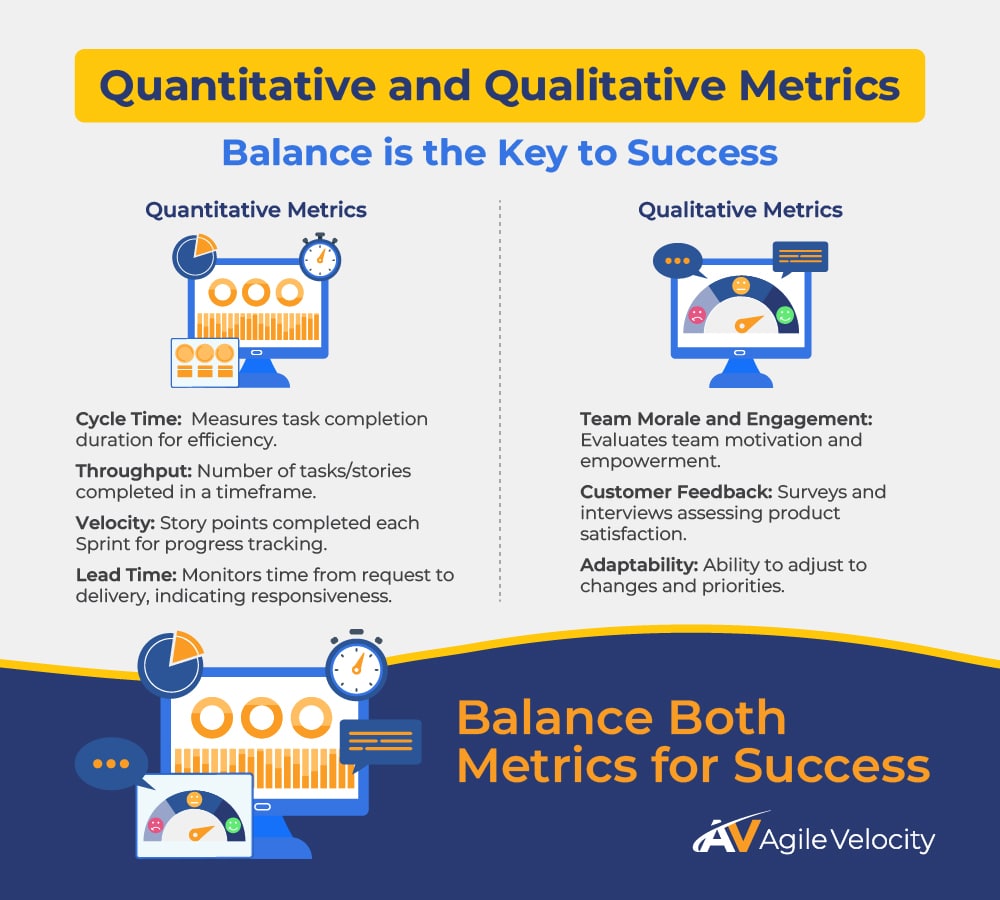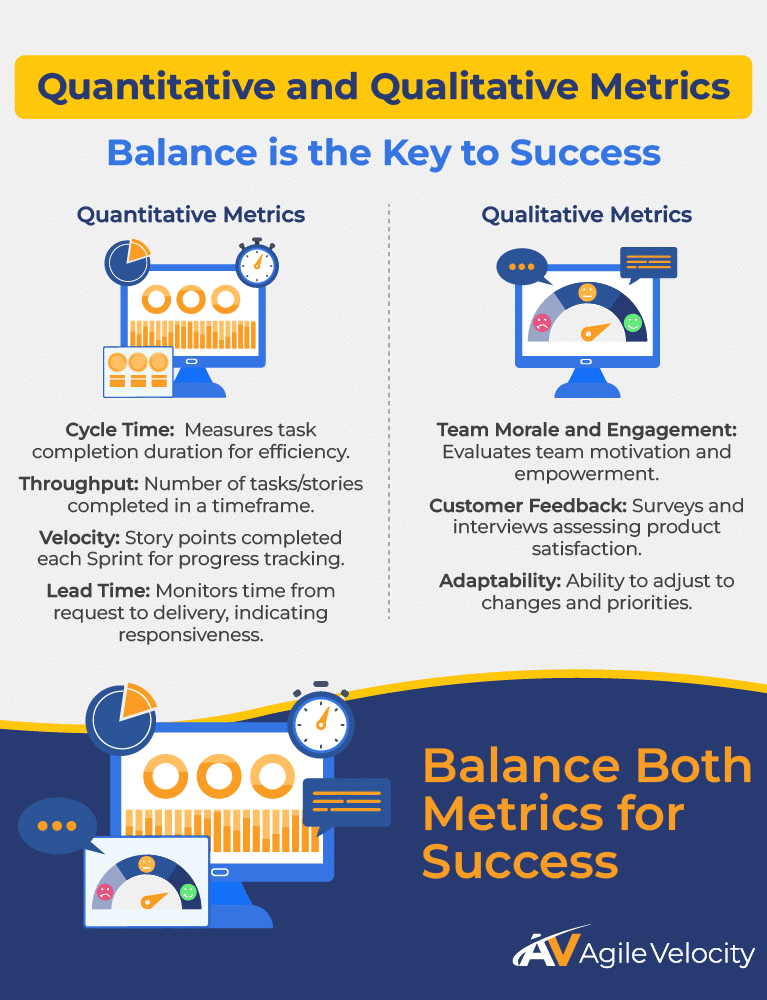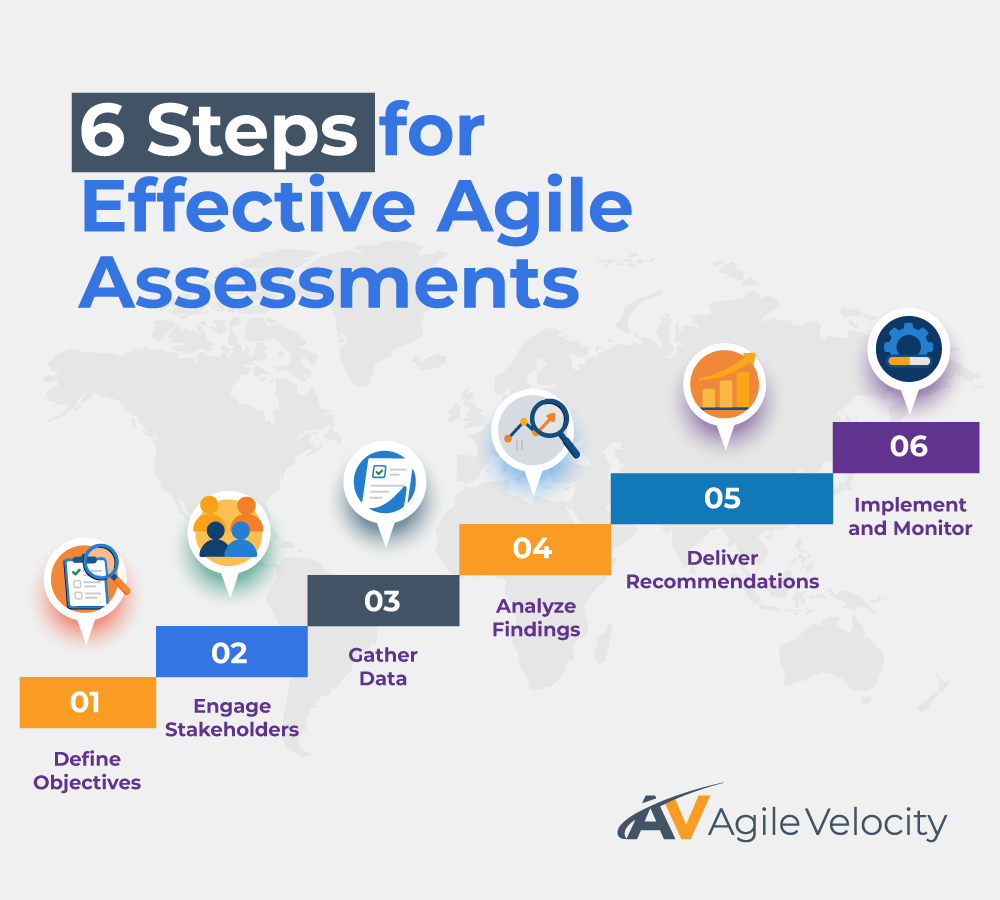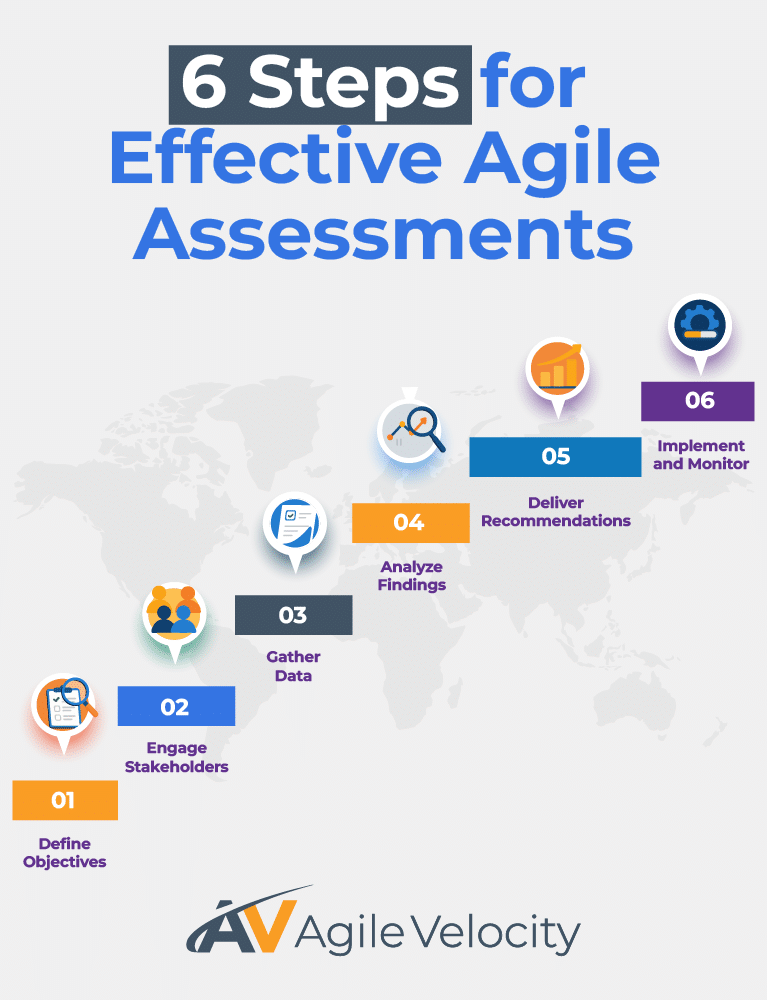Agile Methodologies promise faster value delivery, improved product quality, and enhanced adaptability in today’s business landscape. However, adopting Agile Methodologies doesn’t automatically translate into meaningful results. The key question remains: Are your practices driving measurable business outcomes? Evaluating Agile effectiveness ensures that teams focus on outcomes, rather than just following processes, enabling sustainable improvements, and greater impact.
In this article, we explore how organizations can assess the effectiveness of their Agile practices, identify gaps, and adopt strategies or tools such as Path to Agility® Navigator to drive lasting success.
Why Evaluating Agile Methodologies is Key to Business Success
Adopting an Agile framework without measuring its outcomes can lead to wasted resources, and missed opportunities. Often, organizations get entangled in the mechanics—Sprints, Daily Scrum events, and other rituals—while losing sight of the real goal: delivering value to customers and meeting strategic objectives.
Regular evaluations help you:
- Align Agile efforts with strategic business goals.
- Identify and eliminate inefficient practices.
- Promote continuous improvement through meaningful feedback.
- Validate that your Agile Transformation is producing outcomes such as faster time-to-market, cost savings, or enhanced customer satisfaction.
By focusing on results rather than merely tracking activities, you ensure that every Agile initiative contributes directly to building a competitive, customer-focused organization.
Defining Success in Agile: The Importance of Clear Business Outcomes
Success in Agile is measured by tangible outcomes rather than just adherence to frameworks. Instead of fixating on events like Sprint Planning or the Daily Scrum, focus on the results your teams deliver.
Key outcomes include:
- Faster time-to-market: Delivering features and solutions quickly to stay competitive.
- Improved customer satisfaction: Meeting customer needs effectively and adapting based on feedback.
- Enhanced cost efficiency: Reducing delays, minimizing rework, and optimizing resource usage.
- Higher employee engagement: Empowering teams to work collaboratively and drive shared goals.
Clear objectives ensure that every initiative drives high-value outcomes and keeps teams aligned with the overall organizational vision.
Key Metrics and Approaches to Evaluating Agile Effectiveness
A balanced evaluation of Agile practices requires combining quantitative and qualitative metrics to provide a complete picture of performance.
Quantitative Metrics
- Cycle Time: Measure how long it takes to complete a task. Shorter cycle times often indicate more efficient work.
- Throughput: Count the number of tasks or stories completed in a given timeframe. This reveals overall capacity and productivity.
- Velocity: Track the number of story points completed in a Sprint. Use this metric alongside others to forecast how much work a team can complete in a sprint.
- Lead Time: Monitor the time from when work is requested to its delivery, reflecting overall responsiveness.
Qualitative Metrics
- Team Morale and Engagement: Assess whether team members feel motivated and empowered.
- Customer Feedback: Use surveys and interviews to understand if the products meet customer needs.
- Adaptability: Evaluate how teams respond to changes or last-minute priorities.
Balancing these metrics helps ensure that improvements in process efficiency translate into real value for customers and the business.
The Role of Leadership in Agile Evaluations
Effective leadership is essential for transforming evaluations into meaningful change. Leaders must:
- Foster continuous improvement by building a culture where change is embraced and learning is ongoing,
- Align strategy with execution, ensuring that daily activities are directly tied to broader business outcomes.
- Sustain momentum by providing support and resources that enable teams to implement changes without overwhelming them.
- Leverage expert guidance by partnering with Agile Coaching professionals to accelerate progress.
When leaders prioritize these areas, Agile evaluations become a central tool for driving value and ensuring that each effort contributes to strategic objectives.
Conducting an Agile Effectiveness Audit
An Agile effectiveness audit evaluates how well your practices align with business goals and deliver value.
Here’s a streamlined approach:
- Define Objectives: Identify whether you aim to improve team morale, reduce bottlenecks, or enhance customer satisfaction.
- Engage Stakeholders: Include a mix of roles—from Scrum Master to Product Owner, and leadership—for diverse perspectives.
- Gather Data: Use surveys, interviews, direct observation of Agile events, and review quantitative metrics like velocity and lead times.
- Analyze Findings: Identify trends and map findings to key business objectives.
- Deliver Recommendations: Summarize successes and propose actionable steps, such as refining workflows or adopting new collaboration techniques.
- Implement and Monitor: Turn recommendations into actions and track progress over time with regular follow-ups.
This audit not only highlights areas for improvement but also reinforces practices that contribute to meaningful business outcomes.
Tools and Techniques to Support Agile Evaluations
Access to the right tools is fundamental for effective Agile evaluations. Key solutions include:
Path to Agility Navigator
Path to Agility Navigator helps organizations visualize needed changes and track progress. It identifies specific areas for improvement—from team dynamics to leadership alignment—and offers clear, actionable next steps to drive continuous improvement.
Analytics and Dashboards
Visual dashboards that track metrics like cycle time and throughput offer real-time insights. They reveal bottlenecks quickly and help teams adjust strategies with minimal delay.
AI-Driven Solutions
Advanced AI tools can uncover trends and forecast potential bottlenecks, allowing teams to be proactive rather than reactive.
Framework Considerations
For larger organizations, integrating metrics across multiple teams or release trains is essential. Likewise, incorporating Kanban’s continuous flow can also enhance flexibility, enabling teams to adjust workflows seamlessly.
Adapting Agile Practices to Achieve Desired Business Outcomes
Understanding current performance is only the first step. The real benefit lies in adapting your practices for better alignment with business goals. This iterative approach encourages a culture of flexibility and continuous improvement, ensuring that every Agile initiative supports the overarching strategic goals.
Key strategies include:
- Flexibility Over Rigid Adherence: Modify frameworks as needed to fit your context. If rapid feature delivery is crucial, shorten Sprints or integrate Kanban’s continuous flow.
- Link Adjustments to Goals: Evaluate every change—such as refining team roles or modifying workflows—based on its impact on strategic targets.
- Iterative Improvements: Simple adjustments, like refreshing Sprint Retrospectives, can lead to significant benefits over time.
Adapting Agile practices is essential to maintain alignment with evolving business needs and stay ahead in a competitive landscape. By continuously evaluating and revising Agile processes, organizations can respond more effectively to changes in market demand and internal challenges. Ultimately, by prioritizing adaptability, teams not only optimize their workflows but also foster a responsive and resilient organizational environment.
Overcoming Common Challenges
Implementing Agile evaluations is not without challenges. Common issues include:
- Resistance to Change: Address concerns through clear communication and involvement. Emphasize how changes support both team and organizational success.
- Vanity Metrics: Avoid focusing on numbers that look good on paper but don’t translate into real value. Prioritize metrics that indicate meaningful gains in customer satisfaction and operational efficiency.
- Rigidity in Frameworks: Stay outcome-focused, and don’t hesitate to adapt or blend frameworks to suit your needs.
- Organizational Silos: Promote cross-functional collaboration by creating shared objectives that connect team efforts with broader business goals.
- Change Fatigue: Pace improvements sensibly, celebrate small wins, and offer continuous support and training.
Overcoming these challenges requires a strategic approach characterized by strong leadership and commitment to Agile values. By fostering open communication, promoting adaptability, and focusing on genuine outcomes, organizations can turn potential obstacles into opportunities for growth. Ultimately, a well-executed Agile evaluation strategy can lead to enhanced performance, greater team satisfaction, and a more robust alignment with business objectives.
Building a Culture of Continuous Improvement

Continuous improvement is the cornerstone of Agile. A culture that embraces ongoing learning, experimentation, and iterative change is more likely to achieve ongoing success. Establishing this culture involves:
- Psychological Safety: Create an environment where team members can share concerns and ideas without fear.
- Collaborative Alignment: Break down silos and promote teamwork across departments.
- Data-Driven Decisions: Encourage teams to base changes on measurable outcomes rather than assumptions. Gain insights on data-driven decisions.
- Empowerment Through Feedback: Use regular retrospectives and informal check-ins to keep communication open and drive iterative enhancements.
Fostering a culture of continuous improvement requires collective effort and commitment at all organizational levels. By ingraining these practices into the workplace culture, teams can systematically identify and seize opportunities for optimization. This ongoing refinement not only enhances process efficiency but also bolsters innovation and maintains alignment with dynamic business objectives.
Advanced Strategies for Scaling Agile Evaluations
For companies operating at scale, advanced strategies ensure that Agile evaluations remain robust across all levels of the organization. One effective method is establishing multi-level feedback loops—evaluations occur at both the team and portfolio levels. Regional or departmental teams can conduct localized assessments that feed into a global overview, capturing nuances while maintaining central oversight. Fostering knowledge-sharing across teams also strengthens your organization’s innovation capacity.
Leveraging Leading Agile Change Management and Lean Portfolio Management
Beyond multi-level feedback loops, advanced methods like leading Agile change management and incorporating Lean Portfolio Management can further align Agile initiatives with overarching business goals:
Leading Agile Change Management
Leading Agile Change Management allows organizations to approach change in a systematic, people-centric manner. By understanding employee needs, recognizing cultural dynamics, and mapping out iterative steps, leaders can ensure that process improvements stick. It also helps streamline communication and provide clarity, which are critical for large-scale transformations. For more details, consider Leading Agile Change Management as a proven way to guide teams through new ways of working.
Lean Portfolio Management
When teams need to tie their work directly to business strategy, Lean Portfolio Management offers a structured way to prioritize, fund, and track initiatives. Organizations can continuously assess the value delivered by different portfolios, ensuring optimal resource allocation. By integrating these practices with your Agile evaluations, teams stay aligned on strategic objectives while maintaining flexibility. Explore how Lean Portfolio Management can harmonize budgeting, governance, and execution for a smoother flow of work.
Agile Transformation Integration
Whether your organization employs Scrum, Extreme Programming (XP), Kanban, or another framework, a holistic Agile Transformation approach weaves these methods into one cohesive strategy. Teams can leverage standard evaluations alongside leadership-focused techniques, ultimately creating a fully integrated environment that values outcomes over box-checking. If you’re looking for a strategic rollout or a refresh of your processes at scale, Agile Transformation can be a guiding pillar for long-term success.
Future Trends in Agile Effectiveness Measurement
As technology advances, methods for evaluating Agile practices will also evolve. AI-powered analytics are already helping teams identify risks early, and optimize processes for better outcomes. In the future, we may see more real-time measurement of customer satisfaction embedded directly in product usage patterns. This will give teams immediate insight into whether they are achieving both quality and responsiveness.
Companies may also adopt more sophisticated ROI analyses that tie metrics—like cycle time or lead time—directly to financial performance, clarifying the impact of Agile across product lines. By combining these modern techniques with classic metrics, organizations can stay ahead of competitors and make data-driven decisions to remain resilient.
Sustaining Agile Success Through Ongoing Training
To achieve lasting benefits from Agile evaluations, invest in professional development and ongoing training. Organizations that prioritize skill development often see boosted innovation and higher team engagement. By nurturing these growth opportunities, companies better retain talent and strengthen their capacity to adapt in fast-changing markets. Continuous learning also encourages teams to try new ideas, refine processes, and maintain a forward-thinking mindset that pushes Agile improvements well beyond superficial process changes.
Sustaining Agile Success Through Continuous Adaptation and Innovation

Evaluating Agile effectiveness is essential to ensuring that your Agile Methodologies deliver measurable business value. By focusing on clear outcomes, tracking balanced metrics, and adapting practices based on continuous feedback, organizations can unlock Agile’s full potential. Tools like Path to Agility Navigator, combined with strong leadership and a culture of ongoing improvement, empower teams to drive lasting change.
If you’re ready to elevate your Agile journey and achieve faster, more predictable results, contact Agile Velocity today to discover how our Agile Coaching, Lean Portfolio Management expertise, and innovative tools can help you achieve your business goals with confidence.







